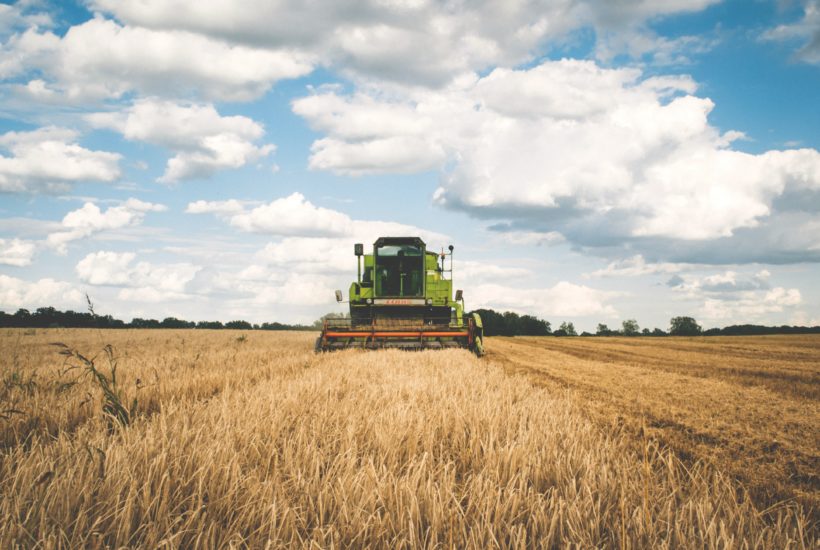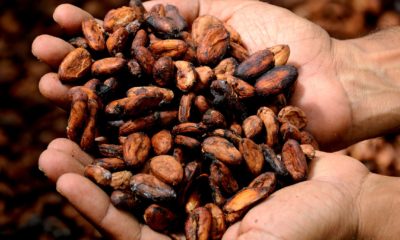Featured
The fate of the futures market depends on both weather and the pandemic
Coffee futures were lower last week in both markets. It has been a weather market and the weather has improved. The rains in Vietnam finally started to end last week as the typhoons seem to have gone away. Central America has seen a couple of hurricanes that could have damaged crops. These systems have now departed the region. The demand from coffee shops and other food service operations is still at very low levels.

Wheat
Winter Wheat markets were lower as US prices moved closer to international prices and US markets searched for new demand. World prices have held steady or worked a little higher even with additional supplies available to the market as Russian prices remain elevated. Australian supplies have increased as its harvest is moving forward. US weather is mixed with still dry conditions in the western Great Plains. Some precipitation was reported in the Midwest. Parts of eastern Ukraine and southern Russia are getting some showers too. These have been late to help much with the establishment but will help with soil moisture into the Spring. Western Australia conditions are good after some rains. The demand has held well and world prices remain high. The market in Russia has remained high on limited supply as farmers hold the Wheat back due to the drought.
Weekly Chicago Soft Red Winter Wheat Futures
Weekly Chicago Hard Red Winter Wheat Futures
Weekly Minneapolis Hard Red Spring Wheat Futures
Corn
Corn was a little lower last week in reaction to weaker than expected export demand and reports of improved conditions in South America. Oats reversed and moved sharply higher last week. Little export demand was noted from China by USDA in the weekly export sales report. It has rained in Argentina and southern Brazil in the past week. Rains will now leave these areas and has moved north into central and southern Brazil. Meanwhile, it will turn warm and dry to the south and this is more consistent with La Nina. Drought could develop in southern Brazil and Argentina despite the rains this week as the overall weather patterns have been dry. The drought is especially serious in South America for the first Corn crop but the second crop could also be affected due to late planting in central and northern Brazil. Dry weather has delayed the Soybeans planting and that will delay the second Corn planting later. Farmers will not plant if it gets too late in the year as the rains will shut off before the crop gets mature. US weather was great for harvesting last week with warm and dry conditions for much of the Midwest. Yield reports have generally been good except for the drought and derecho areas of Iowa. Ukraine has been in drought.
Weekly Corn Futures:
Weekly Oats Futures
Soybeans and Soybean Meal
Soybeans and Soybean Meal closed lower on better rains in South America and the lack of Chinese demand for US Soybeans. China continues to buy in small amounts each day but has canceled some contracts made to unknown destinations in the past week. Production potential is being threatened in South America due to the lack of rainfall. The situation is most serious in central and northern Brazil, but has improved in southern Brazil and Argentina due to recent rains. These rains are leaving southern Brazil and Argentina now and will move to the north. Southern Brazil and Argentina will now turn warm and dry and this will be much more consistent with atypical La Nina pattern. The world will need very strong production from South America to meet the projected demand. The stocks to use ration for Soybeans is now very small and the situation is the tightest projected in years. Higher Soybeans prices are likely.
Weekly Chicago Soybeans Futures:
Weekly Chicago Soybean Meal Futures
Rice
Rice was lower last week as trading reflected the lack of activity in the domestic cash market. Trading volumes have been less for the last couple of weeks. The cash market is slow and the lack of business is reflected in futures volumes traded. Reports indicate that domestic demand has been poor to average with better consumer demand more than offset by much less demand from schools and other institutions. The harvest is over with good field yields and generally good quality reported.
Weekly Chicago Rice Futures
Palm Oil and Vegetable Oils
Palm Oil closed higher and made a new high weekly close. The market was supported late in the week by ideas of tight supplies coming down the road. Production of most vegetable oils in the world is less this year due to a lack of production of oilseeds. The production of Palm Oil is down, too, in both Malaysia and Indonesia. News that India had cut its import tariffs on Palm Oil supported the futures market as well as good demand is coming. Palm Oil prices are relatively high right now so importers are looking at importing Soybean Oil instead due to cost and quality. Soybean Oil and Canola were higher on strong demand ideas. Soybean Oil was a follower. Very strong Palm Oil prices have made buying Soybean and Canola oils the better option. Trends are up in Soybean Oil and in Canola. Demand for Canola has improved in recent weeks. StatsCan reported less production in its reports last week. Canola farmers have reduced selling by now so demand is chasing after fewer supplies.
Weekly Malaysian Palm Oil Futures:
Weekly Chicago Soybean Oil Futures
Weekly Canola Futures:
Cotton
Cotton closed lower but held inside its recent trading range on the charts. Harvest is ongoing amid drier weather conditions in West Texas and the Delta and Southeast. Reports indicate that some Cotton could have been damaged in Georgia and the Carolinas and into eastern Virginia due to the excessive winds and rains caused by the hurricanes. The rains and winds could have damaged fiber and blown fiber out of the bolls. The weekly export sales report showed strong demand last week. Export demand has held strong despite stay at home orders and weaker economies around the world. Traders now hope for even more demand later as the vaccines are given out and the world economies start to recover.
Weekly US Cotton Futures
Frozen Concentrated Orange Juice and Citrus
FCOJ was lower last week after failing to make new highs for the move on the charts. Florida has been spared any hurricanes or other serious storms this year in a year that has been very active for tropical storms. The Coronavirus is still promoting consumption of FCOJ at home. Restaurant and food service demand has been much less as no one is dining out. The weather in Florida is good with frequent showers to promote good tree health and fruit formation. Brazil has been too dry and irrigation is being used. Showers are falling in Brazil now and these need to continue to ensure good tree health. However, it could turn warm and dry again next week. Mexican crop conditions are called good with rains.
Weekly FCOJ Futures
Coffee
Futures were lower last week in both markets. It has been a weather market and the weather has improved. The rains in Vietnam finally started to end last week as the typhoons seem to have gone away. Central America has seen a couple of hurricanes that could have damaged crops. These systems have now departed the region. Brazil is getting some rains now to improve flowering after an extended dry season. The demand from coffee shops and other food service operations is still at very low levels as consumers are still drinking Coffee at home. Reports indicate that consumers at home are consuming blends with more Robusta and less Arabica. The Brazil harvest is over and producers are selling due to the recent extreme weakness in the Real. Ideas are that production is very strong this year as it is the on year for the trees. Central America is also offering right now and offers are increasing. The weather is good in Colombia and Peru.
Weekly New York Arabica Coffee Futures
Weekly London Robusta Coffee Futures
Sugar
New York and London closed lower last week. It has been raining in south central Brazil and the production of cane has been affected. These areas will turn warm and dry this week as the rains move farther to the north but the rains that have fallen have at least temporarily improved conditions. Brazil mills have been producing more Sugar and less Ethanol due to weak world and domestic petroleum prices. About 45% of the crush this year will go to Sugar, from 35% last year. India has a very big crop of Sugarcane this year. The Indian government has not announced the subsidy for exporters of Sugar so no exports are coming out of India yet. Sources told wire services that any subsidy will need to be significant to get export sales on the books. Thailand might have less this year due to reduced planted area and erratic rains during the monsoon season. Rains are moving through the country now from Vietnam and the Pacific. The EU is having problems with its Sugarbeets crop due to weather and disease. Coronavirus has returned to the world and has caused some demand concerns.
Weekly New York World Raw Sugar Futures
Weekly London White Sugar Futures
Cocoa
New York and London closed sharply lower for the week. The move has come as importers look to find a way to source Cocoa without paying a premium demanded by Ivory Coast and Ghana. Both countries have instituted a living wage for producers there and are looking to tax exports to pay the increased wages. Buyers have been accused of using certified stocks from the exchange instead of buying from origin. However, it looks like the exchange buying has come to a halt for now. There are a lot of demand worries as the Coronavirus is making a comeback in the US. Europe is also seeing a return of the pandemic. The North American and European cocoa grinds were at least 4% lower than a year ago and the Asian cocoa grind was down 10% from last year.
Weekly New York Cocoa Futures
Weekly London Cocoa Futures
__
(Featured image by Freestocks.org via Pexels)
DISCLAIMER: This article was written by a third party contributor and does not reflect the opinion of Born2Invest, its management, staff or its associates. Please review our disclaimer for more information.
This article may include forward-looking statements. These forward-looking statements generally are identified by the words “believe,” “project,” “estimate,” “become,” “plan,” “will,” and similar expressions. These forward-looking statements involve known and unknown risks as well as uncertainties, including those discussed in the following cautionary statements and elsewhere in this article and on this site. Although the Company may believe that its expectations are based on reasonable assumptions, the actual results that the Company may achieve may differ materially from any forward-looking statements, which reflect the opinions of the management of the Company only as of the date hereof. Additionally, please make sure to read these important disclosures.

-

 Crowdfunding6 days ago
Crowdfunding6 days agoFrom Confiscation to Cooperation: Funding Casa de la PAZ’s Social Transformation
-

 Impact Investing2 weeks ago
Impact Investing2 weeks agoGlobal Energy Shift: Record $2.2 Trillion Invested in Green Transition in 2024
-

 Business21 hours ago
Business21 hours agoWhy the iGaming Industry Offers Some of the Best ROI for Affiliate Marketers
-

 Crowdfunding1 week ago
Crowdfunding1 week agoDolci Palmisano Issues Its First Minibond of the F&P “Rolling Short term” Program
























